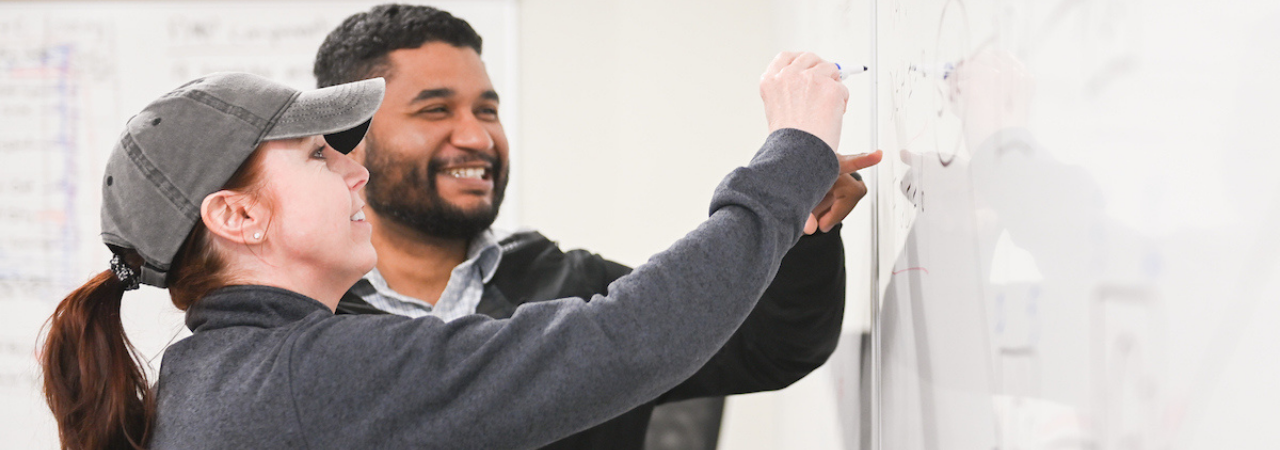 There are several benefits to furthering your education by taking a new course. Maybe you want to prepare for a certification, or perhaps you want to develop professional skills. Sometimes, students who have been out of the classroom for a long time begin to question if they will be able to succeed as they return to the classroom. With the right toolbelt, you can not only complete a course─but THRIVE in doing so. Take a look at seven strategies you can implement to have an enhanced student-learning experience and come out successful on the other side.
There are several benefits to furthering your education by taking a new course. Maybe you want to prepare for a certification, or perhaps you want to develop professional skills. Sometimes, students who have been out of the classroom for a long time begin to question if they will be able to succeed as they return to the classroom. With the right toolbelt, you can not only complete a course─but THRIVE in doing so. Take a look at seven strategies you can implement to have an enhanced student-learning experience and come out successful on the other side.
-
STRATEGY #1: USE PLANNING AS A POWER TOOL.
We understand that you have many responsibilities outside of the classroom, like family, work, and health, to name a few. Without careful planning, you may find yourself trying to finish your homework at the last minute! One way to eliminate this type of stress is to plan well. For short-term planning, use a planner to write down homework assignments or set reminders on your phone when it’s time to work. Develop a long-term plan after you receive your syllabus and create a semester schedule to get lengthy assignments done. It may take trial and error, but find a method that works best for you to avoid procrastination. Also, we recommend (once you develop your study habits) physically writing down the time you want to allot for and what you want to accomplish in your course each day. There is power in creating a routine and planning well. As Benjamin Franklin said, “Failing to plan is planning to fail.”

-
STRATEGY #2: MAKE ARRANGEMENTS IN ADVANCE.
Planning not only applies to homework, but to your outside responsibilities, as well. If you know that you will need a babysitter to take care of your children while you attend class, find one a few days in advance. If you know there is heavier traffic during the time you drive to campus, add an extra 15 minutes to your ETA so you aren’t late. And don’t forget to take the time it takes to park and walk to class into consideration! Thinking about these things ahead of time helps you get rid of stress and get the most out of your classroom experience.
-
STRATEGY #3: UNDERSTAND YOUR PURPOSE.
Ask yourself: Why am I taking this course? Before the course begins, create a list of goals you hope to achieve and the benefits that come along with taking the course (I gain a new skill set, relevant knowledge, etc.) Then, set your list of goals in a place where you will see them regularly (in a homework binder, as your phone lock screen, etc.) Look at your list when you need extra motivation. It’s easy to create goals but never check progress towards them, so we encourage you to check your goals once a week and see if you are where you want to be. Keep yourself accountable and don’t forget to reward yourself when you meet your goals. After completing a small task, reward yourself in fun, creative ways; treat yourself to a Sour Patch Kid or your favorite boxed candy for every 15 minutes of studying you complete. (It will take accountability in itself not to eat the whole box at once!) For long-term projects, reward yourself on a bigger scale, like going out to eat for your favorite meal.

-
STRATEGY #4: STAY ENGAGED.
Focus and concentration are keys to success, both while in the classroom and while studying outside the classroom. You may be working, but if you are constantly turning your attention away from your work, you aren’t working WELL. Engagement is what will help you get the most out of your class and succeed.
When in class, try putting your phone away or on do not disturb and only take calls that are emergencies or out of familial necessity. If you find yourself tempted to scroll through social media, temporarily delete the apps off your phone. Participate in classroom discussions; doing so allows you to connect with your peers and instructor on a deeper level. You’ll also often gain new perspectives by paying attention to others during classroom discussions! Also, don’t be afraid to ask questions. Whether you feel comfortable doing so in class or would rather talk with or email your instructor after, asking questions is a great way to dig deeper into what you are learning and gain greater understanding. Be an active student by taking notes and/or being self-aware enough to absorb what is going on in the classroom around you.
When you’re studying independently, choose a location to work where you will be able to fully concentrate. Some people like a little background noise (such as in a coffee shop) while others need total silence to stay productive. Phones can be helpful and save you time if you only use them for productivity apps, but make sure you aren’t scrolling instead of studying! (It’s a real temptation and a great test of self-control).
-
STRATEGY #5: FIGURE OUT YOUR STYLE.
No, we are not talking about the most comfortable and fashionable outfit to wear while taking your course. Think about how you learn best and implement that into the course. Most people fall into three categories: visual, auditory, or tactile (hands-on). Our instructors implement all three learning styles into the course, but after figuring out your learning style, you can further personalize methods to help you grasp new concepts and employ the best study strategies for you. For example, if you’re a visual learner, soak in PowerPoints the instructor shares. Use Quizlet or hand-held flash cards to study; you can even draw relevant pictures on the flash cards to help with memorization. Do you learn best by listening? Record the instructor’s lectures and replay them at home. If you’re more hands-on, write down notes as your instructor speaks. To study, teach the content to someone else. You can also implement technology into your study habits by finding study apps that are beneficial for you.
Once you’ve established your preferred study location, figure out where you accomplish your best work. If you are a morning person, rise and shine and begin working after you finish your morning routine. More of a night owl? Set aside an hour or two after dinner to crank out assignments. Or, if your kids require your attention in the morning and evening, carve out time for a midday study session while they’re at school. Brew that cup of coffee, put on your go-to playlist, and do whatever you need to do to get down to business.

-
STRATEGY #6: TAKE CARE OF YOUR HEALTH.
This applies to both your physical and mental states. If they are lacking, your concentration and focus will lack, as well. Take care of yourself by getting sleep, drinking water, and eating nourishing foods. If you’re sitting for long periods of time, especially while studying, be sure to regularly check your posture and take breaks to stretch. While studying, do NOT sit starting at your screen for four hours at a time without moving. (This is also unhealthy for your eyesight). Go on walks, call a friend, or make a cup of coffee to recharge physically and mentally. We also can’t underestimate the importance of finding a work/school/life balance; all work and no play is just as toxic as no work and all play! Find ways to coordinate your and your family’s schedules, if possible. You are not being selfish—you are TAKING CARE OF YOURSELF.
-
STRATEGY #7: TAKE ADVANTAGE OF RESOURCES.
First, your instructor is one of your greatest resources. Ask them questions and exchange dialogue about topics that you find particularly interesting. You’ll be able to learn from a knowledgeable expert in the field, and they WANT to pass their knowledge on to you! Your peers are also a helpful resource. Everyone has unique life experiences and backgrounds, and others often have viewpoints to share that can help you grow, learn, and understand how they see the world. There are also many resources available outside the classroom to help you become well-rounded on topics you’re studying and understand the topics even more. Google has several resources for students, such as Google Search, Google Scholar, and Google Books. Find books to read by seeing if the school associated with your course has an online library or by going to your local public library. Soak in knowledge through podcasts, message boards, forums on topics you’re studying…the possibilities are endless!

We hope that these strategies empower you as you begin your journey toward acquiring new skills, becoming more knowledgeable, preparing for a new career, and advancing your life.
Here’s to a future that looks brighter than ever. After all, the best way to predict a brighter future is to create it.